AMD Zen 3 Ryzen Deep Dive Review: 5950X, 5900X, 5800X and 5600X Tested
by Dr. Ian Cutress on November 5, 2020 9:01 AM ESTTDP and Power Draw: No Real Surprises
The nature of reporting processor power consumption has become, in part, a dystopian nightmare. Historically the peak power consumption of a processor, as purchased, is given by its Thermal Design Power (TDP, or PL1). For many markets, such as embedded processors, that value of TDP still signifies the peak power consumption. For the processors we test at AnandTech, either desktop, notebook, or enterprise, this is not always the case.
Modern high performance processors implement a feature called Turbo. This allows, usually for a limited time, a processor to go beyond its rated frequency. Exactly how far the processor goes depends on a few factors, such as the Turbo Power Limit (PL2), whether the peak frequency is hard coded, the thermals, and the power delivery. Turbo can sometimes be very aggressive, allowing power values 2.5x above the rated TDP.
AMD and Intel have different definitions for TDP, but are broadly speaking applied the same. The difference comes to turbo modes, turbo limits, turbo budgets, and how the processors manage that power balance. These topics are 10000-12000 word articles in their own right, and we’ve got a few articles worth reading on the topic.
- Why Intel Processors Draw More Power Than Expected: TDP and Turbo Explained
- Talking TDP, Turbo and Overclocking: An Interview with Intel Fellow Guy Therien
- Reaching for Turbo: Aligning Perception with AMD’s Frequency Metrics
- Intel’s TDP Shenanigans Hurts Everyone
In simple terms, processor manufacturers only ever guarantee two values which are tied together - when all cores are running at base frequency, the processor should be running at or below the TDP rating. All turbo modes and power modes above that are not covered by warranty.
For AMD’s new Ryzen 5000 processors, most of them have a 105 W TDP, with a Package Power Tracking (PPT) setting of 142 W. For these processors, we can see our peak power consumption through our testing matching that value. For the sole 65 W processor, the PPT value is 88 W, and we’re seeing only 76 W, showing some of the efficiencies on the Ryzen 5 5600X.
If we look directly at the Ryzen 9 5950X for chip wide power consumption over per-core loading, we get this following graph. Here we are reporting two of the values that we have access to on the chip, which the chip estimates as part of its turbo detection and action algorithms: total package power (for the whole chip), and the power solely used by the sum of cores, which includes the L3 cache. The difference between the two covers the IO die as well as any chiplet-to-chiplet communications, PCIe, CPU-to-chipset, and DRAM controller consumption.
There are two significant features of this graph.
First is the hump, and a slow decrease in total package power consumption after 8-10 core loading. We saw this when we first tested the previous generation 3950X, and is indicative of how the processor has increased current density as it loads up the cores, and as a result there’s a balance between the frequency it can give, delivering the power, and applying the voltage in a consistent way. We’re seeing the difference between the two values also increasing slightly, as more data is transferred over those off-chiplet communications. We see this effect on the 5900X as well, perhaps indicating this is a feature of the dual chiplet design – we’re not seeing it on the 5800X or 5600X.
The second feature is an odd dip in power moving from 4 to 5 cores loaded. Looking into the data, the frequency of the active cores drops from 4725 to 4675, which isn’t a big drop, however the voltage decreases from 1.38 V to 1.31 V, which seems to be more sizeable drop than other voltage readouts as we scale the core-to-core loading. There’s also a bigger increase in non-core power, up from 16 W to 21 W, which perhaps decreases the power to the cores, reducing the voltage.
This might be an odd quirk of our specific chip, our power test, or it might be motherboard or BIOS specific (or a combination of several factors). We might go back in future on other boards to see if this is consistent.
When we dive into per-core power loading, we get the following:
The big chip’s power distribution seems to go up in that 3-4 core loading before coming back down again. But as we load up the second chiplet moving from 8 to 9 core loading, it is worth noting that the second chipset is reporting lower core power, despite showing the same core frequency. AMD is able to supply the two chiplets different amounts of voltage and power, and we might be seeing this play out in real time.
Perhaps very important is that single core power consumption when we are at 5050 MHz of 20.6 W. Going back to our previous generation data, on Zen 2 we were only seeing a peak of 18.3 W, and a slightly higher voltage reported (1.45 V for Zen 2 vs 1.42 V for Zen 3). This means that from the perspective of our two chips, Zen 3 cores scale better in frequency, and even though the power increases as expected, the voltage simultaneously decreases (Note that there can be some silicon variability to also account for some of this.)
Moving down the stack, the 12-core Ryzen 9 5900X doesn’t show any surprises – we’re seeing the same drop off as we load up the cores, this time as we go beyond eight cores. As this processor uses two chiplets, each with six cores, that second set of six cores seem to be consuming lower power per core as we add in additional load.
Some users might be scratching their heads – why is the second chiplet in both of these chips using less power, and therefore being more efficient? Wouldn’t it be better to use that chiplet as the first chiplet for lower power consumption at low loads? I suspect the answer here is nuanced – this first chipet likely has cores that enable a higher leakage profile, and then could arguably hit the higher frequencies at the expense of the power.
Moving down to a single chiplet but will the full power budget, and there is some power savings by not having the communications of a second chiplet. However, at 8-core load, the 5800X is showing 4450 MHz: the Ryzen 9 processors are showing 4475 MHz and 4500 MHz, indicating that there is still some product differentiation going on with this sort of performance. With this chip we still saw 140 W peak power consumption, however it wasn’t on this benchmark (our peak numbers can come from a number of benchmarks we monitor, not just our power-loading benchmark set).
At the 65 W level of the 5600X, as mentioned before, the all-core frequency is 4450 MHz, which is actually 50 MHz behind the 5800X. However this chip is very consistent, still giving up +50 MHz on its peak turbo compared to the on-box number. It also carries this turbo through to at least 3 core loading, and doesn’t lose much to 5 core loading. Users looking for something low power and consistent could be swayed by this chip.
For some specific real-world tests, we’re going to focus solely on the Ryzen 9 5950X. First up is our image-model construction workload, using our Agisoft Photoscan benchmark. This test has a number of different areas that involve single thread, multi-thread, or memory limited algorithms.
Most of this test sits around the 130 W mark, as the workload has a variable thread count. There are a couple of momentary spikes above 140 W, however everything is well within expected parameters.
The second test is from y-Cruncher, which is our AVX2/AVX512 workload. This also has some memory requirements, which can lead to periodic cycling with systems that have lower memory bandwidth per core options.
Our y-Cruncher test often shows one of two patterns – either a flat line for power-limited processors, or this zig-zag as the test is loaded and also uses a good portion of memory transfers for the calculation. Usually it is the latter which showcases when we’re getting the most out of the processor, and we get this here.
Compared to other processors, for peak power, we report the highest loaded value observed from any of our benchmark tests.
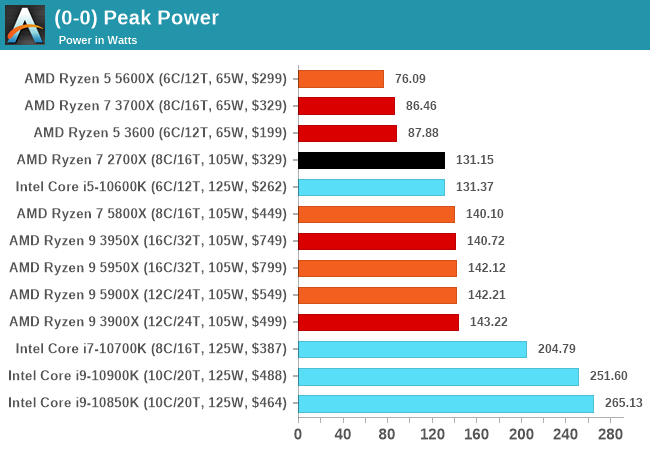
Due to AMD’s PPT implementation, we’re getting very consistent peak power results between multiple generations of AMD processors. Because OEMs play around with Intel’s turbo implementation, essentially to an unlimited peak turbo power, this is why we see full-loaded values well above 200 W. While Intel stays on its most optimized 14nm process and AMD leverages TSMC’s leading 7nm, along with multiple generations of DTCO, AMD will have that efficiency lead.


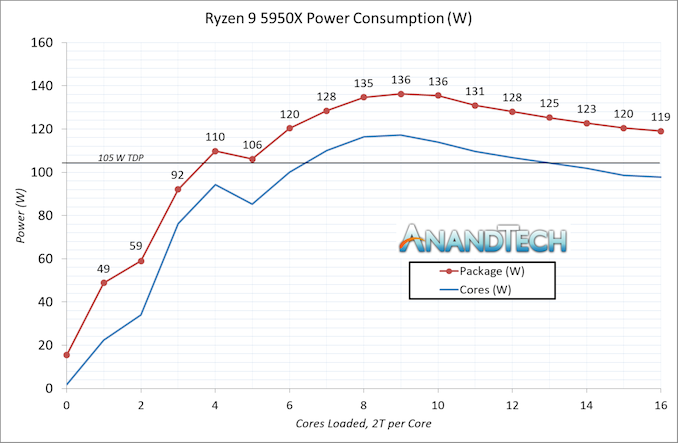
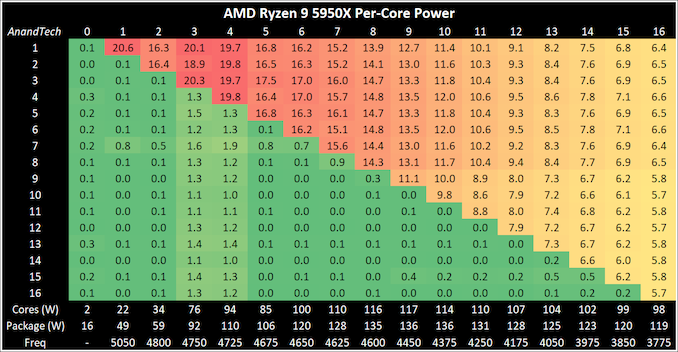
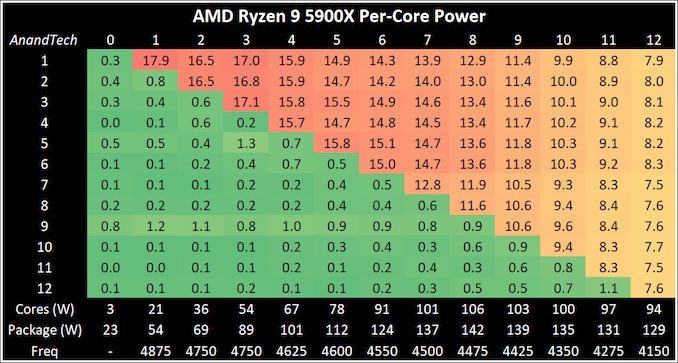
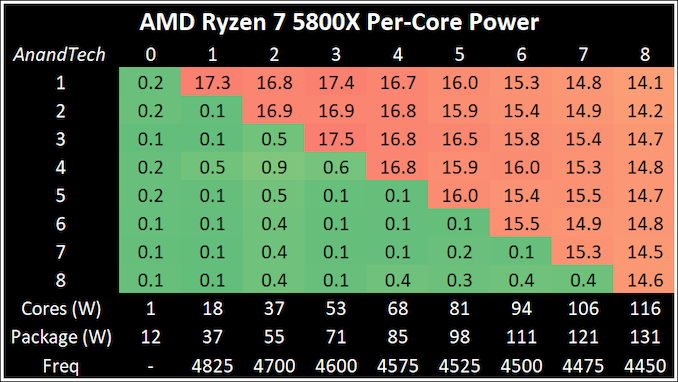


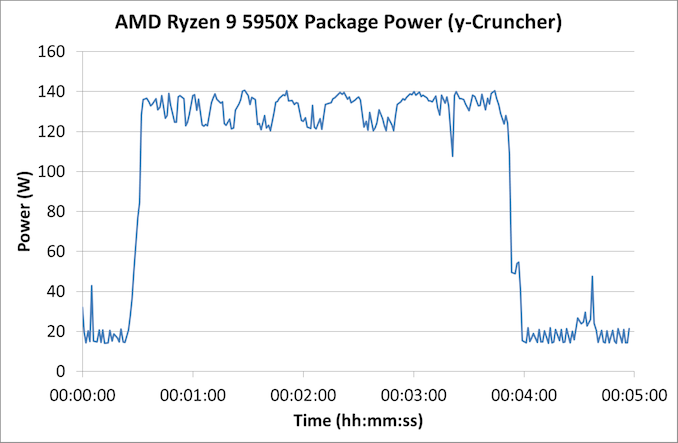








339 Comments
View All Comments
halcyon - Tuesday, November 10, 2020 - link
1. Ryzen 9 5xxx series dominate most gaming benhmarks in CPU bound games up to 720p2. However at 1440P/4K Intel, esp. 10850K pull ahead.
Can somebody explain this anomaly? As Games become more GPU bound at higher res, why does Intel pull ahead (with worse single/multi-thread CPU perf)? Is it a bandwidth/latency issue? If so, where exactly (RAM? L3? somewhere else)? Can't be PCIe, can it?
feka1ity - Saturday, November 14, 2020 - link
RAM. anandtech uses shitty ram for intel systemsMakste - Monday, November 16, 2020 - link
I think the game optimizations for intel processors become clear at those resolutions. AMD has been a none factor in gaming for so long. These games have been developed on and mostly optimised to work better on intel machinesSilma - Wednesday, November 11, 2020 - link
At 4K, the 3700X beats the 5600X quite often.Samus - Friday, November 13, 2020 - link
Considering Intel just released a new generation of CPU's, it's astonishing at their current IPC generation-over-generation trajectory, it will take them two more generations to surpass Zen 3. That's almost 2 years.Wow.
ssshenoy - Tuesday, December 15, 2020 - link
I dont think this article compares the latest generation from Intel - the Willow Cove core in Tiger lake which is launched only for notebooks. The comparison here seems to be with the ancient Skylake generation on 14 nm.abufrejoval - Friday, November 13, 2020 - link
Got my Ryzen 7 5800X on a new Aorus X570 mainboard and finally working, too.It turbos to 4850MHz without any overclocking, so I'd hazard 150MHz "bonus" are pretty much the default across the line.
At the wall plug 210 Watts was the biggest load I observed for pure CPU loads. HWinfo never reporting anything in excess of 120 Watts on the CPU from internal sensors.
"finally working": I want ECC with this rig, because I am aiming for 64GB or even 128GB RAM and 24x7 operation. Ordered DDR4-3200 ECC modules from Kingston to go with the board. Those seem a little slow coming so I tried to make do with pilfering some DIMMs from other systems, that could be shut down for a moment. DDR4-2133 ECC and DDR4-2400 ECC modules where candidates, but wouldn't boot...
Both were 2Rx4, dual rank, nibble not byte organized modules, unbuffered and unregistered but not the byte organized DIMMs that the Gigabyte documentation seeemd to prescribe... Asus, MSI and ASrock don't list such constraints, but I had to go with availability...
I like to think of RAM as RAM, it may be slower or faster, but it shouldn't be tied to one specific system, right?
So while I await the DDR4-3200 ECC 32GB modules to arrive, I got myself some DDR4-4000 R1x8 (no ECC, 8GB) DIMMs to fill the gap: But would that X570 mainboard, which might have been laying on shelves for months actually boot a Ryzen 5000?
No, it wouldn't.
But yes, it would update the BIOS via Q-Flash Plus-what-shall-we-call-it and then, yes, it did indeed recognize both the CPU and those R1x8 DIMMs just fine after the update.
I haven't yet tried those R2x4 modules again, because I am still exploring the bandwidth high-end, but I want to report just how much I am impressed by the compatibility of the AM4 platform, fully aware that Zen 3 will be the last generation in this "sprint".
I vividly remember how I had to get Skylake CPUs in order to get various mainboard ready for Kaby Lake...
I have been using AMD x86 CPUs from 80486DX4. I owned every iteration of K6-II and K6-III, omitted all Slot-A variants, got back with socket-A, 754, 939, went single, quad, and hexa (Phenom II x4+x6), omitted Bulldozer, but did almost every APU but between Kaveri and Zen 3, AMD simply wasn't compelling enough.
I would have gotten a Ryzen 9 5950x, if it had been available. But I count myself lucky for the moment to have snatched a Ryzen 7 5800X: It sure doesn't disappoint.
AMD a toast! You have done very well indeed and you can count me impressed!
Of course I'll nag about missing SVE/MKTME support day after tomorrow, but in the mean-time, please accept my gratitude.
feka1ity - Saturday, November 14, 2020 - link
Interesting, my default 9700k with 1080ti does 225fps avg - Borderlands 3, 360p, very low settings and anantech testers poop 175fps avg with 10900k and 2080ti?!? And this favoritize amede products. Fake stuff, sorry.Spunjji - Monday, November 16, 2020 - link
"Fake stuff"Thanks for labelling your post
feka1ity - Monday, November 16, 2020 - link
Fake stuff is not a label, it's a epicrisis. Go render stuff, spunji